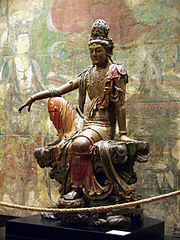CENTER COMMUNITY NEWS
Newsletter of the Center for Sacred Sciences
Vol. 30, No. 3 • Summer 2017
2017 Spring Retreat: The Still Pond & The Hurricane

Retreat Participants: (Top Row) Rick Ahrens, Britt Martin, Marijke McCandless,
Jay McCandless, Dagmar Matson, Fred Chambers, Sandy Itzkowitz, Laurina
Peters, Sally Snyder, Sophia Malkasian, Maura Scanlon; (Seated Row) Mary
Jane Moffat, Ellie Parson, Aloha Heart, Annie O'Shea, Laura Betty, Kathy
Hamer; (Ground) Bill Hamann; Not pictured is Betty Vail
Things that arise in our life can sometimes feel as enormous and tumultuous as a hurricane. On this retreat, practitioners explored how all this activity arises from and dissipates into the stillness of our True Being.
Each evening Annie O'Shea led everyone in a chant, inviting them to discover their inner sacred sound. The retreat also included timely and timeless artwork by several Center artists, providing opportunities to immerse in the Feminine Energy that is swirling about the planet right now. It seems to be a fierce-protective, life-affirming energy that can help heal us and guide us toward selfless love and wisdom.
Thanks to all the visual and musical artists associated with the Center that contributed to the retreat: Carla Crow, Jane Harrison, Annie O'Shea, Kathy Hamer, Dagmar Matson, Rick Ahrens, Bill Hamann, Maura Scanlon, Daphne Sage (aka Deste Gem), Grace Bullock.
Special thanks go to Fred and Annie for their teachings and presence, lightly holding a stable space for deep practice. Last but not least, gratitude and appreciation go to the retreat coordinator, Laura Betty, who managed the retreat with grace and kindness.

"Still Pond and Hurricane" by Carla Crow
Laura Betty's Account of the Retreat
Ripple in still water,
when there is no pebble tossed,
nor wind to blow.
—Robert Hunter
The above quote and theme for our five days with Fred at St. Benedict's Lodge started with the remembrance of our four principles of the path: Attention, Commitment, Detachment, and Surrender. Fred captured our attention with this statement: "Where do I start or begin this love story of the universe? The mystery is that love is beyond words. All words fall short of describing love!"
So looking to the theme again, The Still Pond and The Hurricane, we explored this through art and music (visuals and sounds). By creating a sacred space in meditation, we have an opportunity to welcome the hurricane of thoughts and find that stillness within us, to view our conditioning and habits as teachers/gurus.
Of course, Fred reminded us, it is good to first remember that these stories do not last forever. Thank goodness that everything is constantly arising and dissolving: the impermanence of all thoughts and sensations.
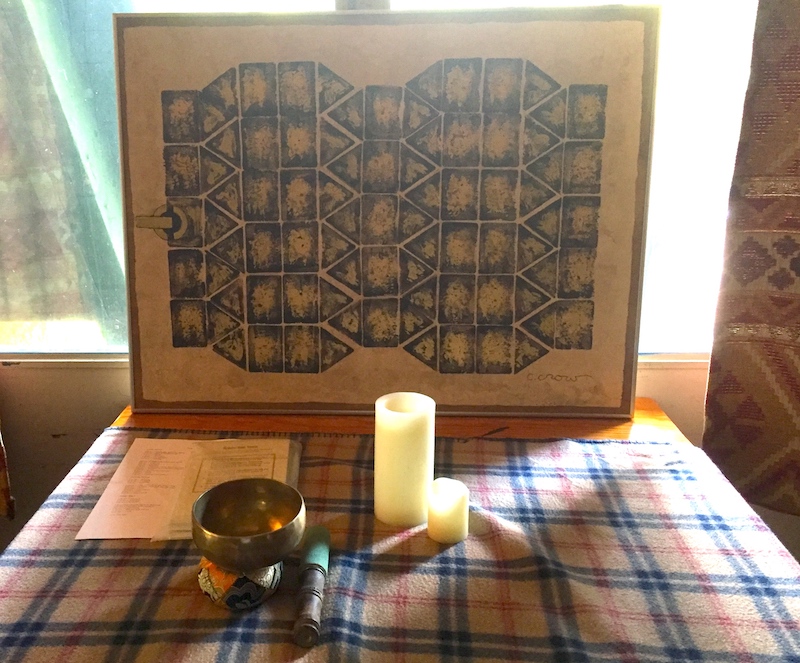
"Heaven's Gate" by Carla Crow
- Attention: We notice these stories - our own "hurricanes."
- Commitment: A serious desire/commitment to our spiritual path.
- Detachment: This is an opportunity to see/feel our attachments. As Fred said,"I see you, love, my guru!"
- Surrender: Watch how our thoughts, stories, and sensations dissolve into the still pond.
The first art work, "Heaven's Gate", by Carla Crow was a big, two-piece painting. For me, this is like the idea of a spiritual path. It is a huge undertaking, self-inquiry, a huge hurricane of attachments. Quoting Fred, "The hurricane is full of thoughts and emotions, but in the center of all that activity is stillness." But when we looked closer at Heaven's Gate with Fred, the Gate had spaces between the painted shapes. There really isn't any gate, only an idea of a gate. The ego-self can take you to the gate (which seems so solid), but not through the gate. Only surrender will take you through the gate, to the still pond.
Fred invited us to investigate this internal hurricane by slowing down our actions. We walked slowly, ate slowly, paid attention to our thoughts both in the meditation room and outside the meditation room. Slowing down allowed us to view the activities of our mind. It helped us see the self-created boundaries of us and the world, our naming and labeling, our attachments and aversions.
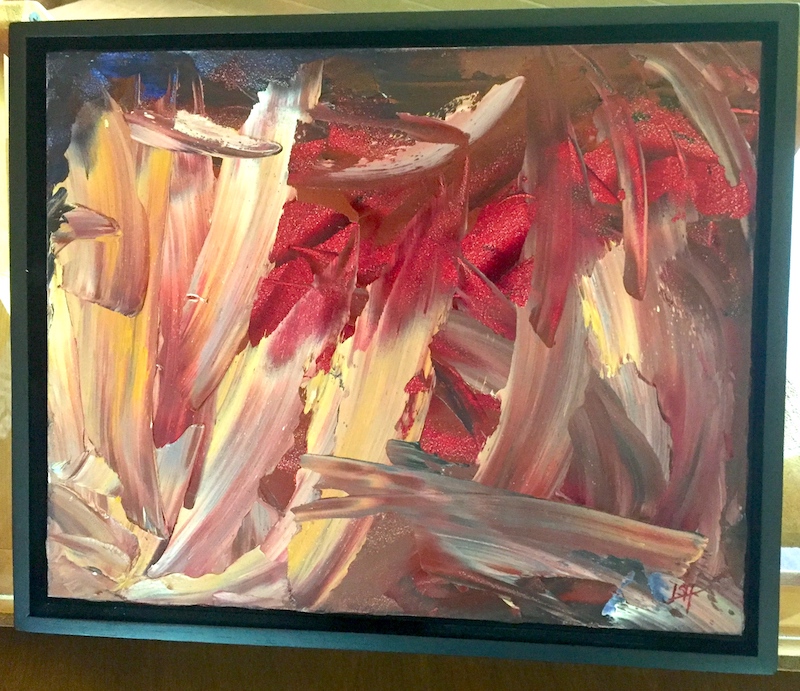
"Into Chaos" by Jane Harrison
As we were practicing concentration meditation, Fred brought out Jane Harrison's oil painting "Chaos." We talked about fear arising. Here is art arising out the fear of the current political climate and, according to Fred, "the fierce-protective, life-affirming feminine energy that is part of the resistance movement." Fear does not have to paralyze us, we can use that energy. It can give us clarity. Jane's "Chaos", to me, portrayed fear, hope, beauty and tenderness in the brush strokes. Fred encouraged us to have a sense of tenderness with our thoughts, and that anything that arises in our consciousness is OK. Nothing is wrong, and there isn't just one way of viewing art or (maybe) our thoughts. There is only Now—that timeless, eternal, non-substantial Now.
Deste Campbell's photo "Full Moon-Snow Moon" was a great example of our tangled thoughts, seen as a tangle of branches, and the centered Moon, our breath, as we noticed subtle laxity or restlessness. Fred invited us to "pause between breaths, and rest in the vastness of the (sky) consciousness."
As we moved into choiceless awareness, Fred displayed Georgia O'Keeffe's, "Pond in the Woods"—an example of how thoughts take us away in the spiral rings of her painting, so softly and subtly. It feels warm and comforting, but those thoughts don't bring us any clarity.
Dagmar Matson's etched and colored gourd (or was it really a beautiful vase?) dramatized how things are not always what they appear to be.
With spaciousness, we viewed Carla Crow's "Unravel the Heart Knots" and Maura Scanlon's photo "Can't be Named." The Heart Knots invited us to be gentle with ourselves, full of love, and know that we are all working on self-inquiry. Maura's photo was mirror images in water. As the photo was rotated we saw different images. Fred pointed out that there is a subtle tension to hold attention on a thought or a story.
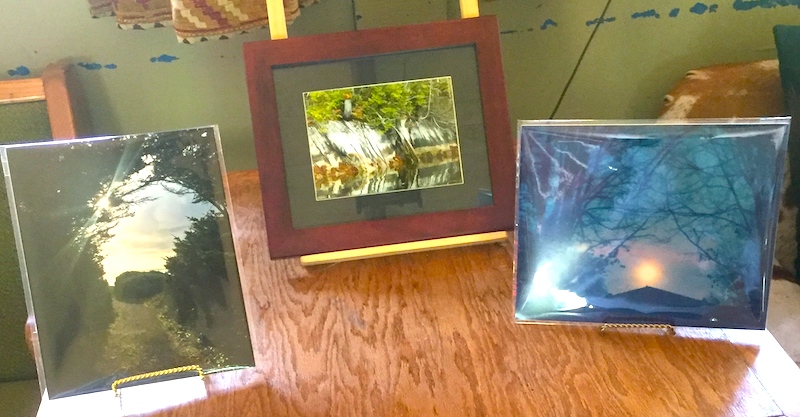
Photos by Grace Bullock, Maura Scanlon,
and Daphne Sage
CSS retreats tend to end with teachings on Enlightenment, as we did with Carla Crow's "Be at Home in the Darkness." And with a photo from Grace that added that sense of spaciousness and stillness-darkness against the light. As Fred said, "Darkness is the Light! They are two sides of the same coin." Our fear of emptiness is just another ripple in the pond. And that ripple can bring you back to stillness."
Kathy Hamer graced three of our morning meditations with her Tibetan singing bowls. The bowls vibrated through our bodies as we dissolved in the sound.
Annie O'Shea, with Rick Ahrens (guitar) and Bill Hamann (drum), led us into music every evening with a wonderful variety of chants. Singing with Annie brought out our fear of singing in public and a created a beautiful sense of unity.
Using non-conceptual means to understanding the teachings of our meditation retreat opened up new avenues of awareness for me. Thank you to all the artists, for sharing your talents and joy with us.
If I missed anyone, my sincere apologies.
—Laura Betty, CSS Retreat Coordinator
Video of Matt's talk
Matt's Easter talk on the Wisdom of Uncertainty
A common form of aversion in life is toward experiences of unknowing and uncertainty: We are apprehensive not knowing what is going to happen, or not understanding what is going on right now. This can be especially acute when we are facing a serious illness or death.
In this talk, Matt encourages us to acknowledge and embrace this radical uncertainty. When we deeply understand and realize that we are never completely certain of anything, then we are free.
Special thanks to CSS videographer Linda Hunt for making this video possible.
Merciful Goddess
The Merciful Goddess sits calm in the Heart,
Create or die, she calls with a start.
Your prayers will be answered, only not how you think,
The lamb has been gutted, there’s a powerful stink.
Exploding catastrophes lined up in a row,
We’re running the gauntlet, what seeds should we sow?
Go forth and create, be happy and sad,
Though dangers you face, you’re a strong lass and lad.
Cleave close to your Heart when there’s trouble or woe,
Let love for all beings spring forth from your soul.
—Fred.
May 15, 2017
Practitioners Group Explores Inner Demons
Todd's practitioners group has been reading excerpts of Lama Tsultrim Allione's book Feeding Your Demons as they continue to explore and practice allowing various forms of suffering ("demons") to self-liberate by bringing attention into aspects of delusion that may otherwise elude attention. The practice of feeding your demons is Tsultrim’s Western adaptation of a traditional Tibetan Buddhist practice known as chod.
Chod, originally developed by another female practitioner, Machig Labdrön (1055 – 1145), defined a demon as
"…anything that obstructs the achievement of freedom (enlightenment). There is no greater devil than this fixation to a self. So until this ego-fixation is cut off, all the demons wait with open mouths. For this reason, you need to exert yourself at a skillful method to sever the devil of ego-fixation."
This "skillful method" may sound like a brutal battle about to ensue, but actually chod is based on the fundamental principle of embracing that which we dislike with kindness and awareness.
Demons are particularly tenacious forms of suffering that may remain despite years of vigilant practice. Even if we direct attention to the outward layers of suffering, our propensity to suffer may continue if we don't see the deeper habitual driving force behind it. Ultimately, the mother of all demons is this unseen demon of self-importance or self-clinging that Machig describes; without it, there are no demons. Can you find such a demon in your own experience? Though the manifest forms of demons are endlessly diverse, here is a list of a few of the demons Tsultrim describes in her book, Feeding Your Demons: post traumatic stress, nightmares, addictions, poor self esteem, compulsive mind states such as perfectionism, fear of death or debilitation, guilt or shame, depression, fear of abandonment, and anxiety. Some demons are clearly qualities of enduring habit, whereas others may seem to be more short-term feelings of upset.
In this practice, once we discover a demon, rather than doing battle with it and trying to get rid of it, we feed it by giving it what it truly needs—which is to be fully known and experienced within compassionate awareness. Fundamental to this is opening awareness to any resistance to the demon which may arise. If it continues to invoke suffering for us despite this introspection, however, Tsultrim offers a series of steps to open into a deepening awareness of it through the creative power of imagination, empathy, and self-surrender. For a brief overview of these steps, see Tsultrim’s article.
Todd provides the following insightful encouragement for this practice:
If you spot what you might consider to be an inner demon, if you become aware of it through repeated practice without clinging to expectations about it, if you allow it to be just as it is, you may discover it is no longer a demon for you. The more aware of it you become, the more likely it will self-liberate on its own. It is important to see that the entire process of becoming aware of it is not to try to get rid of the demon or to change it in the least. Rather, we befriend it by seeing it as clearly as possible, and in so doing, discover what it needs and what drives it to manifest. In other words, we approach it lovingly and with curiosity and in doing so, we naturally free it from suffering.

Jane Sanford Harrison
Sacred Art at CSS: Daily Sketching by Jane Sanford Harrison
The walls of the CSS meeting space are typically adorned with sacred art shared by CSS members. From March-April, 2017, sketches by CSS member Jane Sanford Harrison were on display. Jane has been a teacher, school counselor, researcher, and principal. But she didn't discover that she was an artist until after she retired. Sketching for her is a spiritual meditation. Below is Jane's description of her daily sketching meditation practice.
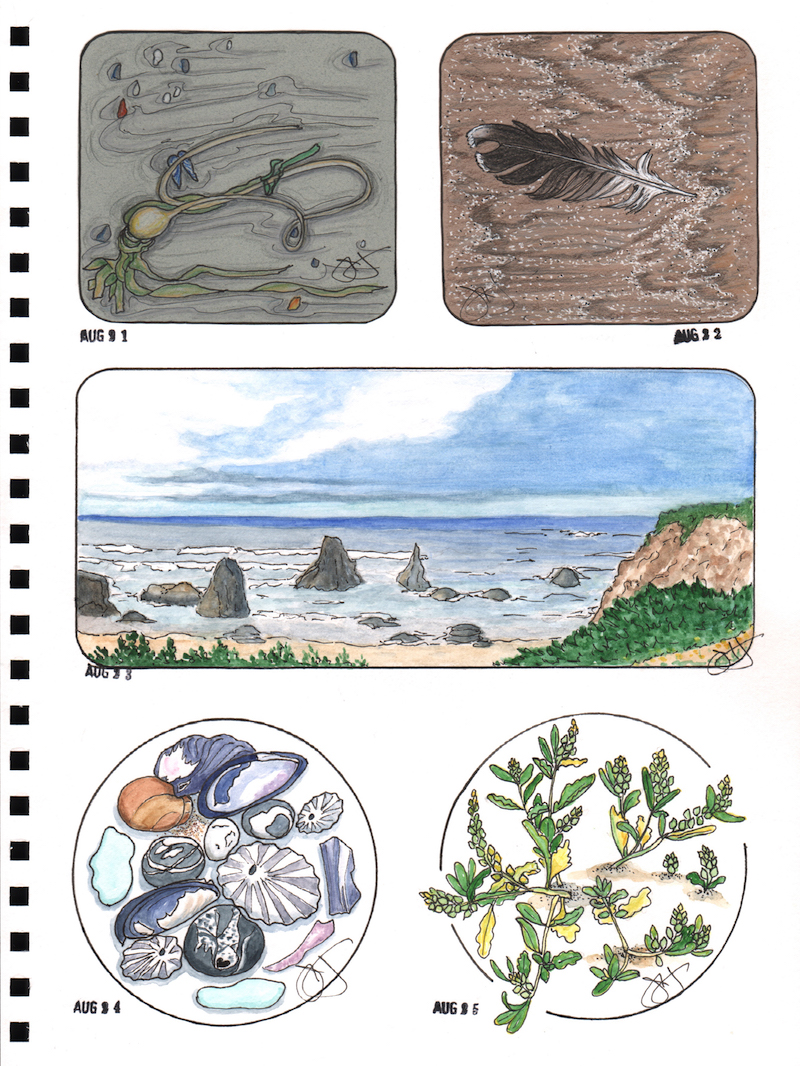
I’m now into the third year of doing a small daily sketch. The first year I did it I called it doing a “gratitude” sketch, and I looked every day for what made me grateful, amused, uplifted, joyous. Every day I would post the sketch on Facebook, and when I finished a page of sketches in my 9” x 12” sketchbook, I would scan it and post it on the Artists Journal Workshop group on Facebook. And suddenly I had a following! At the end of the year, I put all the sketches into a book, A Year of Daily Gratitude Sketches, available at Blurb.com, with an e-book version, too. I realized that doing these daily sketches had a powerfully positive impact on my outlook on life.
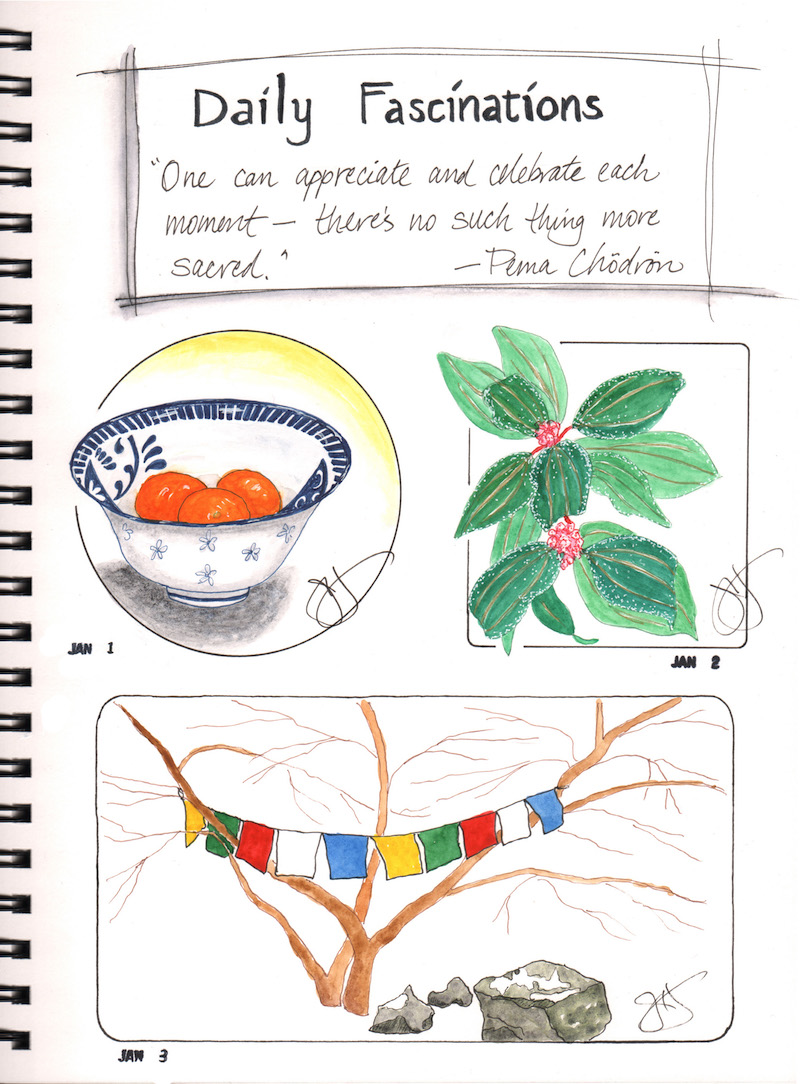
In 2016 I started another daily sketch commitment, and called it “Daily Fascinations.” I followed the same format as before, but this time the sketches would be whatever caught my fancy, what intrigued or puzzled me, what made me curious or appreciative.
Then a series of unforeseen challenges occurred – icy weather, a huge pine tree falling in my yard between my house and the neighbor’s, the demise of my heat pump, the loss of electricity, my family coming for 10 days at Christmas (come to grandma’s and camp in the cold – it will be fun!), my dog being rushed to emergency because of a toxic reaction to chocolate. And I had stopped doing daily sketches – I felt like I had a frozen brain.
Depression accumulated over the following days until I realized I had to do something to counteract it. On January 20, 2017, the day of the presidential inauguration, I began doing daily sketches again, and called them “Gratitude Anyway.”
It turns out that doing the daily sketches is a spiritual practice for me, brightening and enriching my life. I hope you enjoy the samples I’ve shared here, and think about doing this yourself!
—Jane Sanford Harrison
Mysticism, death and dying
Classical Mysticism and its Relation to Death and Dying
Back in 2009, Joel was invited by Steve Cummings to speak at the Palliative Care Conference on Oct. 21, 2009, in San Mateo, California. This 30 min. video of his talk — which only recently became available thanks to Steve — begins with a characteristically lucid and succinct introduction to the core mystical teachings in the world's religious traditions, with pithy quotes from various mystics. For example, all mystics testify that Ultimate Reality is ineffable and nondual; that the root of suffering is the reification of duality, most fundamentally the duality of self and world. Based upon this mistake, we attempt the impossible task of finding lasting peace and satisfaction in ephemeral experiences. The goal of spiritual life is to Recognize Ultimate Reality, which brings an end to the reification of duality and the resulting suffering.
Joel then relates these universal teachings to dying and death. First, from the perspective of the mystics, death is a golden opportunity to Recognize Ultimate Reality, since death naturally removes all distractions of objects and experiences. Second, even if one is not a mystic seeking Recognition of Ultimate Reality, all spiritual traditions view death as a gateway to the Divine. Instead of looking at death as something to be dreaded, we can view it as something potentially wonderful. All we need is a shift in attitude, to view it with curiosity and openness.

Mission and Programs of the Center for Sacred Sciences
The Center for Sacred Sciences is dedicated to the study, practice, and dissemination of the spiritual teachings of the mystics, saints, and sages of the major religious traditions. The Center endeavors to present these teachings in forms appropriate to our contemporary scientific culture. The Center also works to create and disseminate a sacred worldview which expresses the compatibility between universal mystical truths and the evidence of modern science.
Among the Center’s ongoing events are Sunday public services with meditations and talks given by the Center’s spiritual teachers; monthly Sunday video presentations; and — for committed spiritual seekers — weekly practitioners groups and periodic meditation retreats. The Center is accessible. We are a welcoming and inclusive community.
The Center maintains an extensive lending library of books, audios, videos, and periodicals covering spiritual, psychological, philosophical, and scientific subjects. In addition, the Center provides a website containing a great deal of information and resources related to the teachings of the world’s mystics, the universality of mystical truth, and the relationship between science and mysticism. The Center publishes this newsletter providing community news, upcoming programs, book reviews, and other contributions and resources related to the Center’s mission.
The Center for Sacred Sciences is a non-profit, tax-exempt church based in Eugene, Oregon, USA. We rely chiefly on volunteer staff to support our programs, and on donations to meet our operating expenses. Our spiritual teachers give their teachings freely as a labor of love, and receive no financial compensation from the Center.
About the Center Community News
The Center Community News is published on the CSS website several times a year. Its primary purpose is to help foster a community of spiritual practitioners by sharing original teachings, experiences, reflections, artistic expressions, and reports among members of our community.
To submit your original spiritual reflection, report, poetry or art to the newsletter for publication, please use the newsletter submission form.
To subscribe, unsubscribe, or update your existing subscription to the Center Community News, please use the subscription form.
Center for Sacred Sciences • (541) 345-0102 • General contact form
Mailing Address: 1430 Willamette St., #164 Eugene, OR 97401-4049 USA
Meeting Address: 5440 Saratoga St., Eugene, Oregon, USA

